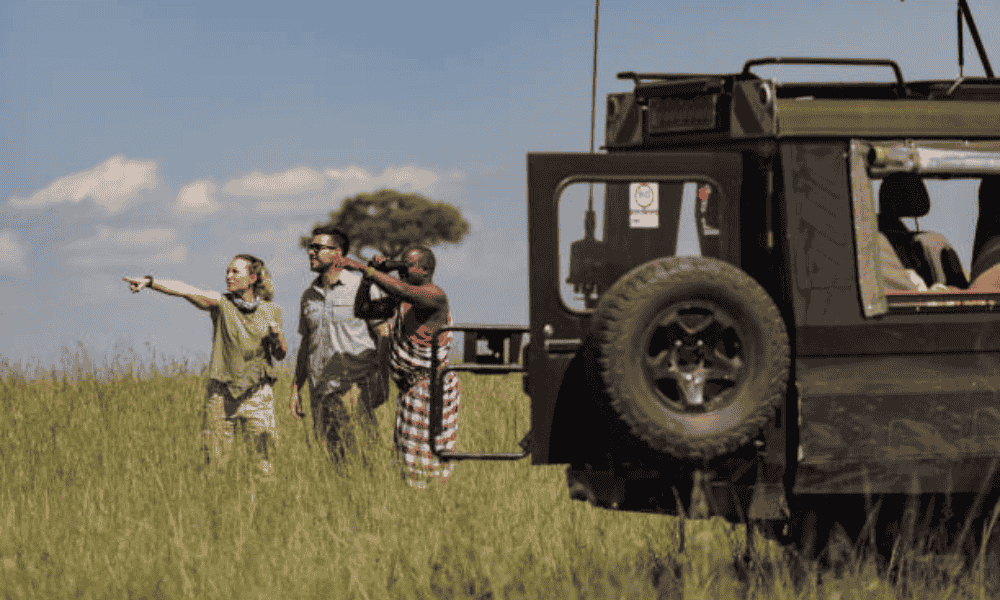A safari in Kenya is not just a vacation, it’s an adventure into one of the most diverse ecosystems on the planet. Today through Naicef, you are going to teach you on what to pack for a safari in Kenya.
From the rolling savannahs of Tsavo to the flamingo-filled lakes of the Great Rift Valley, Kenya’s natural beauty is unmatched but to enjoy it fully, proper preparation is key and what to pack for a safari in Kenya.
You’ll need to think about what to pack for in A safari to Kenya, what animals you’re hoping to see, and most importantly, what to wear on a safari in Kenya, whether you’re staying in a luxury lodge, a rustic tented camp, or something in between.
Learning what to pack for a safari in Kenya also means knowing the climate across different regions, choosing versatile clothing, packing essential gear like binoculars and insect repellent, and respecting local customs and wildlife.
Whether you prefer guided group safaris or personalized private tours, Kenya offers options for every type of traveler you only need to know what to pack for a safari in Kenya before time gets you.
Safety, sustainability, and respect for local communities and nature should also shape your packing choices and choosing what to wear on a safari in Kenya.
Throughout this guide, you’ll find helpful insights, expert tips, and practical advice to make your adventure extraordinary this includes what to wear on a safari in Kenya.
With the right preparation and thoughtful packing, your safari to Kenya can become more than just a trip, it can be a transformative journey into the heart of Africa.
So, are you stressing out about what to pack for a safari in Kenya?
Please don’t, Naicef has got your back; not only on what to pack for a safari in Kenya but also what to wear on a safari in Kenya, Packing list for Maasai mara , clothes to wear on a safari in Kenya and what not to wear on a safari in Kenya.
Contact my@naicef.com or call +254799922277 for the best tips on how to pack for a safari to Kenya and also best Kenya safari packages
Book The Tour Here
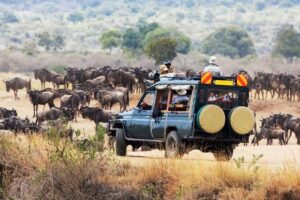
What To Wear On A Safari In Kenya
Planning a safari is an exciting process, but to ensure your trip is safe, smooth, and unforgettable, it’s crucial to understand what to wear on a safari in Kenya.
Knowing what to wear on a safari in Kenya by choosing right fabrics and colors to adapting to changing weather and respecting local customs, your clothing choices can enhance your entire safari experience.
1. Book Early (6–9 Months in Advance)
While this may not directly relate to what to wear on a safari in Kenya, booking early gives you enough time to plan your wardrobe thoughtfully, especially if you’re traveling during peak seasons like the Great Migration (July–October).
Kenya’s most popular camps and lodges fill up quickly, so early planning helps avoid last-minute packing stress.
Key tips:
- Plan your outfits for what to wear on a safari in Kenya for both warm days and cool nights.
- Check accommodation laundry services to minimize overpacking.
2. Get Vaccinated and Visit a Travel Clinic
Your health is essential, and visiting a travel clinic 4–6 weeks before your trip ensures you’re protected, especially when considering what to wear on a safari in Kenya.
Some vaccines require aftercare that affects clothing choices (e.g., avoiding sun exposure), and malaria prevention may influence your need for full-coverage clothing.
Recommended vaccinations:
Yellow Fever
- Hepatitis A & B
- Typhoid
- Tetanus
- Rabies (optional)
- COVID-19 (check current rules)
- Long-sleeved shirts and pants also help minimize insect bites.
3. Apply for a Kenyan Visa Online
Securing your visa is essential before departure, but it also ties into what to wear on a safari in Kenya.
Knowing your itinerary and regions to be visited will help you pack accordingly for diverse climates.
Checklist:
• Apply online via eCitizen Kenya
• Ensure passport validity
• Pack printed/digital visa copy
4. Dress Smart for the Safari Environment
This section is at the heart of understanding what to wear on a safari in Kenya, as safari conditions range from chilly mornings to hot afternoons and breezy evenings.
Recommended clothing:
- Neutral-toned clothes (avoid bright or dark colors)
- Long-sleeved shirts and lightweight trousers
- A fleece or light jacket for cool mornings
- A wide-brimmed hat and sunglasses
- Comfortable walking shoes or boots
- Accessories: binoculars, camera, sunscreen, insect repellent
- Soft-sided bags preferred for light aircraft travel
5. Travel Insurance and Protective Clothing
While insurance is crucial, part of being prepared also means knowing what to wear on a safari in Kenya for possible challenges—dust, sudden weather changes, or minor injuries.
That’s why what to wear on a safari in Kenya includes durable, layered, and protective gear.
Make sure your insurance covers:
- Medical evacuation
- Trip interruption
- Delays or lost items
- Adventure- related activities
6. Cultural Respect and Safari Etiquette
Respecting local norms ties into what to wear on a safari in Kenya, especially when visiting towns, villages, or interacting with local communities.
Do
clothes to wear on a safari in Kenya:
- Wear modest clothing in public settings
- Follow your guides lead on appropriate attire
- Ask permission before photographing people
Don’t
what not to wear on a safari in Kenya:
- Dress in revealing or flashy clothing
- Wear camouflage (illegal in some areas)
- Disregard cultural expectations
7. Prepare Yourself Physically and Mentally (Including Clothing)
Early mornings, bumpy rides, and long days call for both stamina and the right gear. A big part of what to wear on a safari in Kenya includes being ready for active, sometimes demanding conditions.
Suggestions:
- Break in your safari shoes before traveling
- Try layering outfits for flexibility
- Read up on weather expectations and dress accordingly
8. Organize Your Clothing and Accessories Digitally
One last part of preparing what to wear on a safari in Kenya is organizing and backing up packing lists and shopping receipts.
Checklist:
- Save clothing checklists and travel docs in cloud storage
- Keep digital copies of gear purchases in case of loss
- Create mix-and-match outfit plans to stay efficient
Tips On What To Wear On A Safari In Kenya
- Give yourself time by booking early
- Choose clothing that supports health and safety
- Match your attire to your planned destinations
- Wear neutral, practical, and layered outfits
- Include clothing in your risk management plan
- Dress respectfully for cultural interactions
- Prepare physically with appropriate gear
- Digitally organize your packing plans
Tips On What Not To Wear On A Safari In Kenya
1. Bright Colors (e.g., red, yellow, neon)
- Why to avoid: Bright colors can startle wildlife and make you stand out in the bush, reducing your chances of close encounters hence they become one of what not to wear on safari in Kenya.
- What to wear on safari in Kenya instead: Stick to earth tones like olive, khaki, tan, and brown.
2. Camouflage Clothing
- Why to avoid: While it might seem practical, camouflage is illegal for civilians in Kenya (and many African countries) as it’s reserved for the military hence they become one of what not to wear on safari in Kenya.
- What to wear on safari in Kenya instead: Neutral safari clothing without military patterns.
3. Dark Blue or Black Clothing
- Why to avoid: These colors attract tsetse flies, which can bite and cause discomfort or disease hence they become one of what not to wear on safari in Kenya.
- What to wear on a safari in Kenya instead: Light, muted colors that don’t attract insects.
4. White Clothing
- Why to avoid: White gets dusty very quickly on game drives and draws unwanted attention to you, both from wildlife and insects hence they become one of what not to wear on safari in Kenya.
- What to wear on a safari in Kenya instead: Light beige, taupe, or gray are better options.
5. Sleeveless Shirts / Shorts (in certain settings)
- Why to avoid: They expose you to mosquitoes and sunburn, especially during early morning or dusk drives hence they become one of what not to wear on safari in Kenya.
- What to wear on a safari in Kenya instead: Long-sleeved shirts and trousers made from breathable fabrics for protection.
6. Heels or Fashion Sandals
- Why to avoid: Unsuitable for bush walks, uneven terrain, and lodge settings. They also don’t offer foot protection hence they become one of what not to wear on safari in Kenya.
- What to wear on a safari in Kenya instead: Sturdy walking shoes or hiking boots; flip-flops can be worn around your camp or lodge.
7. Jeans or Heavy Fabrics
- Why to avoid: Jeans are hot, heavy, slow-drying, and uncomfortable in Kenya’s varied temperatures hence they become one of what not to wear on safari in Kenya.
- What to wear on a safari in Kenya instead: Lightweight cotton or moisture-wicking synthetic safari pants.
8. Excessive Jewelry or Flashy Accessories
- Why to avoid: Jewelry can be noisy, attract unnecessary attention, and is impractical in the wild. It also increases your risk for theft in urban areas hence they become one of what not to wear on safari in Kenya.
- What to wear on a safari in Kenya instead: Minimal, subtle accessories, if any.
9. Slogans or Political/Religious Prints
- Why to avoid: Inappropriate or controversial statements can be offensive or culturally insensitive, especially in local villages hence they become one of what not to wear on safari in Kenya.
- What to wear on a safari in Kenya instead: Plain or wildlife-themed clothing is always safe.
10. Revealing Clothing (especially in towns or cultural visits)
- Why to avoid: Kenya is a conservative country, and modesty is appreciated in public and around local communities hence they become one of what not to wear on safari in Kenya.
- What to wear on a safari in Kenya instead: Cover shoulders and knees when visiting villages, markets, or local areas outside safari parks.
By following these tips on what to wear on a safari in Kenya, you’ll stay comfortable, respectful, and adventure-ready, ensuring your Kenyan safari is truly unforgettable.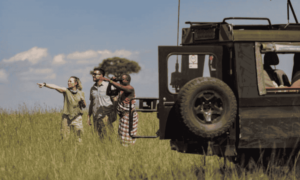 Ready to pack smart? Let Naicef help you customize your wardrobe checklist or suggest the best local safari outfitters!
Ready to pack smart? Let Naicef help you customize your wardrobe checklist or suggest the best local safari outfitters!
3-Day Safari Itinerary To Maasai Mara National Reserve
This 3-day safari itinerary is designed to give you a thrilling introduction to the packing list for Maasai Mara, ensuring you’re fully equipped for an unforgettable experience in this iconic reserve.
Known for its breathtaking landscapes, rich wildlife, and the awe-inspiring Great Migration, the Mara is a must-see for any traveler, but having the right packing list for Maasai Mara can make all the difference in how much you enjoy your time in the bush.
Whether you’re a first-time visitor or a seasoned explorer, this short yet impactful journey takes you straight into the heart of safari country, with a thoughtfully curated packing list for Maasai Mara guiding what to wear, carry, and prepare for.
Over the course of three days, you’ll travel from Nairobi to the open plains of the Maasai Mara, encountering everything from lions and elephants to wildebeest crossing the Mara River (season permitting).
With expertly guided game drives and cozy accommodations in the wild, the right packing list for Maasai Mara ensures you’re ready for early mornings, dusty trails, and unpredictable weather, all part of the magic.
This itinerary balances action-packed wildlife viewing with peaceful moments in nature, offering both excitement and serenity, with every moment made smoother by following a well-planned packing list for Maasai Mara.
Whether you’re planning a quick getaway or want to add a short safari to a longer trip, this route, paired with a practical packing list for Maasai Mara; delivers an immersive, efficient, and unforgettable experience.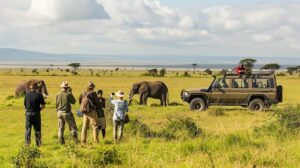 let the journey begin the journey with Naicef:
let the journey begin the journey with Naicef:
| Days | Time | Activity | Place to Stay |
| Day 1 | Morning | Depart Nairobi by road (6–7 hrs.) or flight (1 hr.) to Maasai Mara | Check-in at lodge/camp (e.g., Basecamp Explorer, Mara Serena, Governors’ Camp) |
| Afternoon | Arrive at camp, have lunch and relax | Same as above | |
| Late Afternoon | Evening game drive – see elephants, lions, and giraffes as sun sets | Overnight in Maasai Mara lodge/camp | |
| Evening | Dinner at the lodge/camp and safari briefing | ||
| Day 2 | Early Morning | Depart for full-day safari – carry packed breakfast & lunch | Same lodge/camp |
| Mid-Morning | Explore Mara River – possible wildebeest river crossing in migration season | ||
| Afternoon | Continue game viewing – search for the Big Five, cheetahs, and hippos | ||
| Late Afternoon | Return to camp, relax | Overnight in Maasai Mara lodge/camp | |
| Evening | Dinner, storytelling by campfire (some camps include Maasai cultural talks) | ||
| Day 3 | Early Morning | Sunrise game drive – excellent for lion sightings and soft morning light | Same lodge/camp |
| Mid-Morning | Breakfast at camp, check-out | ||
| Late Morning | Depart Maasai Mara for Nairobi (road or flight) | End of safari | |
| Late Afternoon | Arrive in Nairobi, transfer to hotel or airport | Optional: Nairobi hotel if staying overnight |
5-Day Classic Wildlife Safari Tour In Kenya
This 5-day wildlife safari combines three of the top destinations in Kenya, Amboseli, Lake Naivasha, and the iconic Maasai Mara.
It’s the perfect itinerary for travelers looking to explore Kenya’s diverse landscapes and abundant wildlife in just under a week.
From the snow-capped backdrop of Mount Kilimanjaro to the vast plains of the Mara, every stop offers a unique adventure.
Amboseli National Park is renowned for its large elephant herds and stunning views of Kilimanjaro.
Lake Naivasha, a freshwater lake in the Rift Valley, is a haven for birds and hippos, offering a relaxed contrast to the savannah.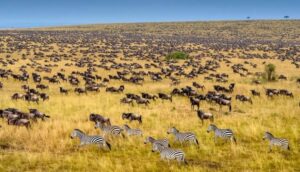 Finally, Maasai Mara remains the crown jewel of the trip.
Finally, Maasai Mara remains the crown jewel of the trip.
To make the most of your experience in this legendary reserve, it’s important to prepare with a thoughtful packing list for Maasai Mara including layers for variable weather, neutral-toned clothing, and essential gear like binoculars and insect repellent.
Whether you’re a first-timer or a returning explorer, this tour not only takes you through Kenya’s top safari locations but also reminds you of the importance of a well-planned packing list for Maasai Mara.
Having the right items ensures you’re ready for early morning game drives, warm afternoons, and cooler evenings under the stars.
If you’re short on time but want to see Kenya’s highlights, this itinerary, backed by a smart packing list for Maasai Mara, delivers a comfortable, immersive, and unforgettable wildlife experience.
| Day | Time | Activity | Place to Stay |
| Day 1 | Morning | Depart Nairobi by road (6–7 hrs.) or flight (1 hr.) to Maasai Mara | Check-in at lodge/camp (e.g., Basecamp Explorer, Mara Serena, Governors’ Camp) |
| Afternoon | Arrive at camp, have lunch and relax | Same as above | |
| Late Afternoon | Evening game drive – see elephants, lions, and giraffes as sun sets | Overnight in Maasai Mara lodge/camp | |
| Evening | Dinner at the lodge/camp and safari briefing | ||
| Day 2 | Early Morning | Depart for full-day safari – carry packed breakfast & lunch | Same lodge/camp |
| Mid-Morning | Explore Mara River – possible wildebeest river crossing in migration season | ||
| Afternoon | Continue game viewing – search for the Big Five, cheetahs, and hippos | ||
| Late Afternoon | Return to camp, relax | Overnight in Maasai Mara lodge/camp | |
| Evening | Dinner, storytelling by campfire (some camps include Maasai cultural talks) | ||
| Day 3 | Early Morning | Sunrise game drive – excellent for lion sightings and soft morning light | Same lodge/camp |
| Mid-Morning | Breakfast at camp, check-out | ||
| Late Morning | Depart Maasai Mara for Nairobi (road or flight) | End of safari | |
| Late Afternoon | Arrive in Nairobi, transfer to hotel or airport | Optional: Nairobi hotel if staying overnight |
10-Day Safari & Coast Immersion Itinerary
This 10-day itinerary offers a complete Kenyan experience, combining both thrilling inland safaris and a relaxing coastal escape.
You’ll journey through iconic destinations like Amboseli National Park, Lake Naivasha, Lake Nakuru, and the world-renowned Maasai Mara, where having the right packing list for Maasai Mara is essential to ensure your experience is as smooth and enjoyable as possible.
After witnessing big game and breathtaking landscapes, you’ll head to Kenya’s stunning coastline, either Diani Beach or Watamu, for rest, marine exploration, and vibrant Swahili culture.
Whether you’re a wildlife enthusiast, culture lover, or beachgoer, this adventure is ideal for anyone wanting to explore Kenya in a balanced, immersive way.
From elephants under the shadow of Mount Kilimanjaro to the Big Five of the Mara, and from flamingos at Lake Nakuru to snorkeling in the Indian Ocean, the journey is unforgettable, but it all starts with smart preparation, especially your packing list for Maasai Mara.
Proper clothing, footwear, and gear can significantly enhance your safari days before you unwind at the coast.
If you’re searching for a journey that includes both inland wildlife and coastal serenity, this itinerary brings together two sides of the country, uniting game drives and white sand beaches.
A well-prepared packing list for Maasai Mara ensures you’re ready for the rugged beauty of the wild before transitioning into the laid-back charm of the coast.
It’s a fantastic option for couples, families, or honeymooners looking to experience Kenya at its best, with both nature and comfort in mind, and a reliable packing list for Maasai Mara guiding your safari adventure.
| Day | Time | Activity | Place to Stay |
| Day 1 | Morning | Arrive in Nairobi, airport transfer, settle in | Fairview Hotel, Tamarind Tree Hotel, or similar |
| Afternoon | Optional visit to Giraffe Centre or Nairobi National Museum | Same as above | |
| Day 2 | Morning | Visit Nairobi National Park or David Sheldrick Wildlife Trust | Same as above |
| Afternoon | Relax and prepare for safari departure | ||
| Day 3 | Early Morning | Drive to Amboseli National Park (4–5 hrs.) | Amboseli Serena Lodge, Kibo Safari Camp |
| Afternoon | Game drive with views of Mount Kilimanjaro | Overnight in Amboseli | |
| Day 4 | Early Morning | Sunrise game drive – elephants, lions, and more | Same as above |
| Afternoon | Relax or take an optional cultural visit to a local Maasai village | ||
| Day 5 | Morning | Depart Amboseli; travel through Lake Nakuru and Lake Naivasha | Overnight at Lake Naivasha Sopa Lodge or Lake Nakuru Lodge |
| Afternoon | Boat ride on Naivasha / Birdwatching or flamingo spotting in Nakuru | Same as above | |
| Day 6 | Early Morning | Drive to Maasai Mara (approx. 5–6 hours) | Zebra Plains Mara, Basecamp Explorer, or similar |
| Late Afternoon | Optional evening game drive on arrival | Overnight in Maasai Mara | |
| Day 7 | Early Morning | Full-day safari – Big Five, wildebeest (in season), picnic lunch | Same as above |
| Evening | Return to camp; dinner under the stars | ||
| Day 8 | Morning | Fly or drive back to Nairobi, then connect to Diani or Watamu | Diani Sea Resort, Medina Palms, or similar (coastal) |
| Afternoon | Arrive at beach, relax, enjoy sunset on the Indian Ocean | Overnight on the coast | |
| Day 9 | All Day | Enjoy marine adventures – snorkeling, dolphin tours, or water sports | Same beach resort |
| Evening | Seafood dinner, local Swahili culture, or beach bonfire | ||
| Day 10 | Morning | Final swim or stroll on the beach | |
| Midday | Transfer to Mombasa or Malindi Airport, fly to Nairobi for departure | End of Tour |
Conclusion
Planning a safari tour in Kenya is not just about booking flights and choosing a lodge it’s about designing a journey that blends adventure, comfort, and authentic experience.
Understanding what to pack for a safari in Kenya is just as important as choosing your route.
With Kenya standing tall as one of the world’s most iconic wildlife destinations, knowing what to pack for a safari in Kenya ensures you’re always prepared whether it’s for dusty game drives or chilly early mornings in the bush.
Every seasoned traveler agrees that what to pack for a safari in Kenya can shape your level of comfort, engagement, and overall experience.
That’s why making a detailed checklist of what to pack for a safari in Kenya including essentials like binoculars, sun protection, and insect repellent is highly recommended.
And finally, don’t underestimate what to pack for a safari in Kenya when it comes to personal items such as medications, travel documents, and tech gear.
Equally important is knowing what to wear on a safari in Kenya, especially since clothing choices can affect not just your comfort, but also your safety and wildlife interaction.
Neutral tones like khaki, olive, or brown are ideal another golden rule of what to wear on a safari in Kenya.
Avoid flashy colors or anything too tight; blending in is both respectful and practical. Having lightweight layers is key when considering what to wear on a safari in Kenya, since mornings can be chilly while afternoons are typically hot.
Comfort, breathability, and mobility define the best choices for what to wear on a safari in Kenya, especially for long game drives or bush walks.
And don’t forget: closed shoes and sun hats are must-haves when deciding what to wear on a safari in Kenya.
Creating a thorough packing list for Maasai Mara helps set the stage for a smooth and rewarding adventure.
With unpredictable weather and dramatic landscapes, a smart packing list for Maasai Mara will include not just clothing and toiletries, but gear like camera accessories, reusable water bottles, and guidebooks.
Most travelers who’ve been will confirm that a well-prepared packing list for Maasai Mara can make the difference between feeling like a tourist or an experienced explorer.
Make sure your packing list for Maasai Mara accounts for seasonal changes—July through October can be dusty and dry, while April brings rain and lush scenery.
Before departing, review your packing list for Maasai Mara with your tour operator to ensure nothing important is left behind.
Now, let’s talk about what not to wear on a safari in Kenya. Avoid camouflage it’s illegal for civilians and could create problems at security checkpoints.
Another item on the list of what not to wear on a safari in Kenya is bright colors, especially red or white, which can scare animals or attract insects.
High heels, synthetic fabrics, and flashy jewelry also top the list of what not to wear on a safari in Kenya, especially during cultural village visits.
While it may be tempting to dress for photos, remember that practicality outweighs fashion when it comes to what not to wear on a safari in Kenya.
Trust us—being prepared and respectful is far more valuable than worrying about what not to wear on a safari in Kenya based on city-style norms.
Lastly, understanding clothes to wear on safari in Kenya plays a crucial role in your overall experience.
Breathable fabrics and UV-protective materials should top the list of clothes to wear on safari in Kenya, particularly when you’re out all day under the sun.
For those early morning drives, layering up with fleece or a light jacket fits perfectly into your plan for clothes to wear on safari in Kenya.
It’s not just about function clothes to wear on safari in Kenya also reflect cultural respect, especially when you visit local communities or villages.
Being mindful of modesty and tradition while choosing clothes to wear on safari in Kenya enhances the authenticity and warmth of your cultural encounters.
So, how do you put it all together?
Planning a safari tour in Kenya begins by choosing the type of experience that aligns with your travel style and budget.
Whether it’s a group adventure or a luxury fly-in safari, knowing how to plan ensures you make the most of every moment from golden sunrises over the savannah to once-in-a-lifetime wildlife sightings.
Understanding what to pack, what to wear, and preparing the right packing list for Maasai Mara makes you travel smarter, lighter, and more connected to your journey.
Mixing iconic spots like the Maasai Mara and Amboseli with less-crowded gems like Samburu, Tsavo, or Lake Nakuru gives you a richer taste of Kenya’s biodiversity and traditions.
A safari isn’t just about animals it’s about people, places, and profound connections. Partnering with a trusted tour operator like Naicef will help handle your logistics, offer customized itineraries, and connect you with cultural experiences beyond the brochure.
Whether you’re tracking lions on the plains, standing face-to-face with elephants beneath Mt. Kilimanjaro, or dancing with villagers by firelight, this journey will live in your memory forever.
Start with knowledge. Continue with curiosity. And finish with an experience that’s etched into your soul.
Are you still wondering how to plan a Safari to Kenya? You got a solution, contact my@naicef.com or call +254799922277 only for the awaiting best experiences! You can also;
Book The Tour Here
Frequently Asked Questions (FAQ)
1. What to pack for a safari in Kenya?
Pack light but smart. Essentials include breathable clothing, insect repellent, sunscreen, a hat, reusable water bottle, sunglasses, binoculars, and a good camera. A small daypack for daily excursions is also useful. Don’t forget your travel documents and any necessary medications.
2. What clothes to wear in safari Kenya?
Opt for neutral-colored clothing like khaki, beige, or olive to blend into the environment and avoid attracting insects. Long sleeves and pants help protect against sunburn and bugs, especially during early morning and evening game drives. Comfortable walking shoes or boots are recommended.
3. What is the recommended packing list for Maasai Mara tours?
When visiting the Maasai Mara, include warm layers for early morning drives, a lightweight rain jacket (especially from April–June), a sunhat, high-SPF sunscreen, and a flashlight or headlamp. Bring culturally respectful attire for village visits—avoid tight or revealing clothes.
4. What not to wear on a safari in Kenya?
Avoid wearing bright colors like red, white, or blue, as they can scare animals or attract insects. Steer clear of camouflage clothing unless you’re in the military—it’s prohibited for civilians in Kenya. Also skip synthetic fabrics that don’t breathe well in the heat.
5. Do I need any special gear for cultural village tours in Kenya?
Not really, but it helps to carry a gift or token of appreciation like school supplies or simple essentials (check with your tour operator). A respectful attitude, closed shoes for walking through rugged terrain, and modest attire will ensure a smooth, respectful cultural exchange.
